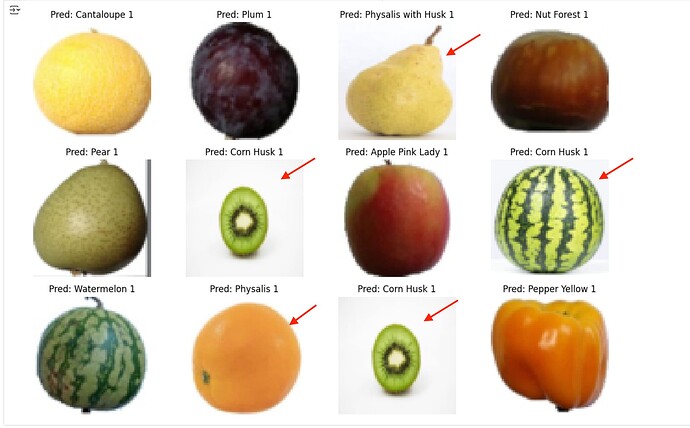Hi,
I’m trying to create my first image classificator for college project. I tried to follow this tutorial:
And got it working - model accuracy is ~85%. But when I try to classificate random images from the web (pretty similiar) I don’t get accurate predictions. Can You please help me to understand why all predictions with photos from the web are wrong? How to correct my code to achieve valid classifications?
Here’s my code:
import torch
import torchvision
import torch.nn as nn
import kagglehub
from torchvision.transforms import ToTensor
from torchvision.datasets import ImageFolder
import os
import torch.nn.functional as F
from tqdm.notebook import tqdm
from torchvision.utils import make_grid
from torch.utils.data import random_split
from torch.utils.data.dataloader import DataLoader
import matplotlib.pyplot as plt
# %matplotlib inline
path = kagglehub.dataset_download("moltean/fruits")
print("Path to dataset files:", path)
newPath = "/root/.cache/kagglehub/datasets/moltean/fruits/versions/11/fruits-360_dataset_100x100/fruits-360"
# newPath = "/root/.cache/kagglehub/datasets/moltean/fruits/versions/11/fruits-360_dataset_original-size/fruits-360-original-size"
print(newPath)
if os.path.exists(newPath):
print(f"Zawartość folderu {newPath}:")
for item in os.listdir(newPath):
print(item)
else:
print(f"Ścieżka {newPath} nie istnieje!")
data_dir = "/root/.cache/kagglehub/datasets/moltean/fruits/versions/11/fruits-360_dataset_100x100/fruits-360"
print('Folders :', os.listdir(data_dir))
classes = os.listdir(data_dir + "/Training")
print('131 classes :', classes)
from torchvision import transforms
transform = transforms.Compose([
transforms.Resize(64),
transforms.ToTensor(),
])
dataset = ImageFolder(data_dir + '/Training', transform=transform)
print('Size of training dataset :', len(dataset))
test = ImageFolder(data_dir + '/Test', transform=transform)
print('Size of test dataset :', len(test))
img, label = dataset[101]
print(img.shape)
def show_image(img, label):
print('Label: ', dataset.classes[label], "("+str(label)+")")
plt.imshow(img.permute(1, 2, 0))
show_image(*dataset[101])
torch.manual_seed(20)
val_size = len(dataset)//10
train_size = len(dataset) - val_size
train_ds, val_ds = random_split(dataset, [train_size, val_size])
len(train_ds), len(val_ds) # train_ds length = dataset length - val_ds length
batch_size = 64
train_loader = DataLoader(train_ds, batch_size, shuffle=True, num_workers=2, pin_memory=True)
val_loader = DataLoader(val_ds, batch_size*2, num_workers=2, pin_memory=True)
test_loader = DataLoader(test, batch_size*2, num_workers=2, pin_memory=True)
for images, labels in train_loader:
fig, ax = plt.subplots(figsize=(18,10))
ax.set_xticks([]); ax.set_yticks([])
ax.imshow(make_grid(images, nrow=16).permute(1, 2, 0))
break
def get_default_device():
"""Pick GPU if available, else CPU"""
if torch.cuda.is_available():
return torch.device('cuda')
else:
return torch.device('cpu')
def to_device(data, device):
"""Move tensor(s) to chosen device"""
if isinstance(data, (list,tuple)):
return [to_device(x, device) for x in data]
return data.to(device, non_blocking=True)
class DeviceDataLoader():
"""Wrap a dataloader to move data to a device"""
def __init__(self, dl, device):
self.dl = dl
self.device = device
def __iter__(self):
"""Yield a batch of data after moving it to device"""
for b in self.dl:
yield to_device(b, self.device)
def __len__(self):
"""Number of batches"""
return len(self.dl)
def accuracy(outputs, labels):
_, preds = torch.max(outputs, dim=1)
return torch.tensor(torch.sum(preds == labels).item() / len(preds))
class ImageClassificationBase(nn.Module):
def training_step(self, batch):
images, labels = batch
out = self(images)
loss = F.cross_entropy(out, labels)
return loss
def validation_step(self, batch):
images, labels = batch
out = self(images)
loss = F.cross_entropy(out, labels)
acc = accuracy(out, labels)
return {'val_loss': loss.detach(), 'val_acc': acc}
def validation_epoch_end(self, outputs):
batch_losses = [x['val_loss'] for x in outputs]
epoch_loss = torch.stack(batch_losses).mean()
batch_accs = [x['val_acc'] for x in outputs]
epoch_acc = torch.stack(batch_accs).mean()
return {'val_loss': epoch_loss.item(), 'val_acc': epoch_acc.item()}
def epoch_end(self, epoch, result):
print("Epoch [{}], train_loss: {:.4f}, val_loss: {:.4f}, val_acc: {:.4f}".format(
epoch, result['train_loss'], result['val_loss'], result['val_acc']))
class CnnModel(ImageClassificationBase):
def __init__(self):
super().__init__()
self.network = nn.Sequential(
nn.Conv2d(3, 32, kernel_size=3, padding=1),
nn.ReLU(),
nn.Conv2d(32, 64, kernel_size=3, stride=1, padding=1),
nn.ReLU(),
nn.MaxPool2d(2, 2),
nn.Conv2d(64, 128, kernel_size=3, stride=1, padding=1),
nn.ReLU(),
nn.MaxPool2d(2, 2),
nn.Conv2d(128, 256, kernel_size=3, stride=1, padding=1),
nn.ReLU(),
nn.MaxPool2d(2, 2),
nn.Flatten(),
nn.Linear(256 * 8 * 8, 512),
nn.ReLU(),
nn.Dropout(0.25),
nn.Linear(512, 141)
)
def forward(self, xb):
return self.network(xb)
model = CnnModel()
# model.cuda()
for images, labels in train_loader:
print('images.shape:', images.shape)
out = model(images)
print('out.shape:', out.shape)
#print('out[0]:', out[0])
break
device = get_default_device()
device
train_dl = DeviceDataLoader(train_loader, device)
val_dl = DeviceDataLoader(val_loader, device)
to_device(model, device)
@torch.no_grad()
def evaluate(model, val_loader):
model.eval()
outputs = [model.validation_step(batch) for batch in val_loader]
return model.validation_epoch_end(outputs)
def fit(epochs, lr, model, train_loader, val_loader, opt_func=torch.optim.SGD):
history = []
optimizer = opt_func(model.parameters(), lr)
for epoch in range(epochs):
model.train()
train_losses = []
for batch in tqdm(train_loader):
loss = model.training_step(batch)
train_losses.append(loss)
loss.backward()
optimizer.step()
optimizer.zero_grad()
result = evaluate(model, val_loader)
result['train_loss'] = torch.stack(train_losses).mean().item()
model.epoch_end(epoch, result)
history.append(result)
return history
model = to_device(CnnModel(), device)
history=[evaluate(model, val_loader)]
history
num_epochs = 1
opt_func = torch.optim.Adam
lr = 0.001
history+= fit(num_epochs, lr, model, train_dl, val_dl, opt_func)
history+= fit(num_epochs, lr/10, model, train_dl, val_dl, opt_func)
def plot_accuracies(history):
accuracies = [x['val_acc'] for x in history]
plt.plot(accuracies, '-x')
plt.xlabel('epoch')
plt.ylabel('accuracy')
plt.title('Accuracy vs. No. of epochs')
plt.show()
def plot_losses(history):
train_losses = [x.get('train_loss') for x in history]
val_losses = [x['val_loss'] for x in history]
plt.plot(train_losses, '-bx')
plt.plot(val_losses, '-rx')
plt.xlabel('epoch')
plt.ylabel('loss')
plt.legend(['Training', 'Validation'])
plt.title('Loss vs. No. of epochs')
plt.show()
plot_accuracies(history)
plot_losses(history)
evaluate(model, test_loader)
torch.save(model.state_dict(), 'cnn_model.pth')
torch.save(model, 'cnn_model_full.pth')
import random
import torch
import matplotlib.pyplot as plt
def show_random_images_with_predictions(model, test_loader, classes, device, num_images=5):
model.eval()
images, labels = next(iter(test_loader))
images, labels = images.to(device), labels.to(device)
with torch.no_grad():
outputs = model(images)
_, preds = torch.max(outputs, dim=1)
fig, axes = plt.subplots(1, num_images, figsize=(15, 8))
for i in range(num_images):
ax = axes[i]
ax.imshow(images[i].permute(1, 2, 0).cpu())
ax.set_title(f'Pred: {classes[preds[i]]}\nTrue: {classes[labels[i]]}')
ax.axis('off')
plt.show()
show_random_images_with_predictions(model, test_loader, dataset.classes, device, num_images=5)
print('131 classes :', classes)
model = torch.load('cnn_model_full.pth')
model.eval()
import os
from PIL import Image
import torch
from torchvision import transforms
import matplotlib.pyplot as plt
transform = transforms.Compose([
transforms.Resize((64,64)),
transforms.ToTensor()
])
model = model.to(device)
def show_predictions_for_sample_images(model, folder_path, classes, device, transform=None):
model.eval()
images = os.listdir(folder_path)
fig, axes = plt.subplots(3, 4, figsize=(12, 8))
axes = axes.flatten()
for i, image_name in enumerate(images):
image_path = os.path.join(folder_path, image_name)
img = Image.open(image_path).convert('RGB')
if transform:
img = transform(img)
img = img.unsqueeze(0).to(device)
with torch.no_grad():
output = model(img)
_, pred = torch.max(output, dim=1)
ax = axes[i]
ax.imshow(img.squeeze().permute(1, 2, 0).cpu())
ax.set_title(f'Pred: {classes[pred]}')
plt.tight_layout()
plt.show()
folder_path = "/content/sampleFruits"
show_predictions_for_sample_images(model, folder_path, dataset.classes, device, transform)
And here are the predictions i get:
Thanks in advance for any suggestions !
